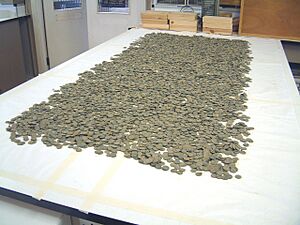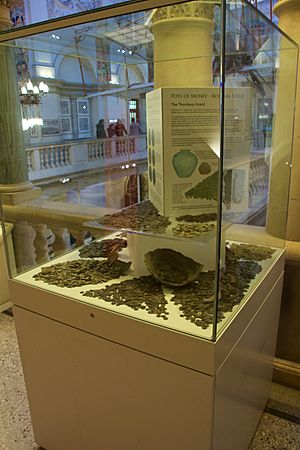Thornbury Hoard facts for kids
Quick facts for kids Thornbury Hoard |
|
|---|---|

Coins from the hoard, photographed in 2007
|
|
| Material | Silver, pottery |
| Size | 11,460 coins |
| Period/culture | Romano-British |
| Discovered | Thornbury, South Gloucestershire by Ken Allen in March, 2004 |
| Present location | Bristol City Museum and Art Gallery, Bristol |
| Identification | 2004 T147 (Fig 450) |
The Thornbury Hoard is a huge collection of 11,460 ancient Roman coins. These coins, mostly called radiates and nummi, were made between the years 260 and 348. They were found in March 2004 by Ken Allen in his backyard in Thornbury, South Gloucestershire, England. He was digging a pond when he made this amazing discovery. This collection was described as the "third largest of its kind" ever found in Great Britain.
Contents
Finding the Ancient Treasure
The Thornbury Hoard was discovered by a man named Ken Allen. He was digging a pond in his backyard when he found something unexpected. The coins were inside a large pot made of grey pottery. This pot was about 40 to 50 centimeters (16 to 20 inches) tall. Experts believe the pot might have come from a place called Caldicot in Wales.
Mr. Allen quickly reported his exciting find. He took the pot and coins to the Bristol City Museum and Art Gallery. The entire collection weighed about 28.6 kilograms (63 pounds)! It was so heavy that it took two people to lift the bucket it was in. Most of the coins were easy to identify after they were dried and cleaned.
What Happened Next?
After the discovery, a special meeting called an inquest was held. At this meeting, the Coroner officially declared the hoard to be "Treasure". This means the coins are very important to history. Because it was declared Treasure, the hoard now belonged to the Crown (the government).
However, Mr. Allen, as the finder, was rewarded. A committee valued the entire collection at £40,000. The Bristol City Museum and Art Gallery wanted to keep the hoard. They managed to buy it with help from the Heritage Lottery Fund and other groups. Now, everyone can see this incredible piece of history at the museum!
What Was Inside the Hoard?
The Thornbury Hoard was truly massive. It contained 11,449 copper alloy nummi coins and 11 copper alloy radiates. The oldest coins in the hoard were made around the year 260. These were from the time of a Roman emperor named Gallienus. The newest coins were made in 348, during the time of the Constantinian dynasty.
Most of the coins were made in the 330s. Many of them had a special design on the back. This design showed "Gloria Exercitus", which means "to the glory of the army". These coins often showed two soldiers holding legionary standards (flags). Other coins were made to remember important places. They showed the Roman capital cities of Rome and Constantinople.
Some coins even celebrated a big battle called the Battle of Chrysopolis. This battle was fought between two important Roman leaders, Constantine I and Licinius. These coins showed the goddess Victory standing on the front of a ship.
How Does it Compare to Other Hoards?
The Thornbury Hoard is one of the largest Roman coin discoveries in Britain. Its size and what it contained were similar to two other famous hoards. These were the Nether Compton hoard, found in 1989 with 22,670 coins, and the Bishopswood hoard, found in 1895 with 17,548 coins.
A Look at the Coins
The table below shows the different types of coins found in the Thornbury Hoard. It also shows when they were made and how many of each type were found.
| Reign | Date range | № of coins | Type | Notes |
|---|---|---|---|---|
| Gallienus | 260–268 | 2 | radiate | |
| Claudius II | 268–270 | 1 | radiate | |
| Tetricus I/II | 271–274 | 6 | radiate | |
| Carausius | 287–293 | 1 | radiate | |
| – | – | 1 | barbarous radiate | |
| Constantine I | 313–317 | 13 | nummi | inc 2 nummus fractions |
| Constantine II | 318–330 | 59 | nummi | |
| Constantinian | 330–335 | 11,232 | nummi | Gloria Exercitus (2 commemorative standards) |
| Constantinian | 335–340 | 87 | nummi | Gloria Exercitus (legionary standard) |
| Constantinian | 341–348 | 2 | nummi | Two Victories |
| – | – | 49 | barbarous nummi | |
| – | – | 7 | uncertain | illegible |


